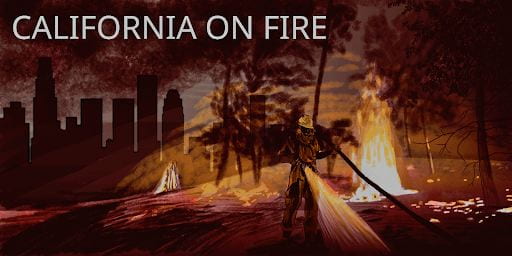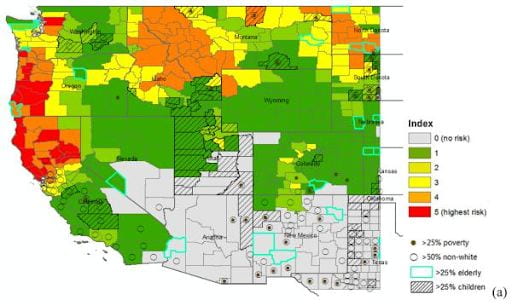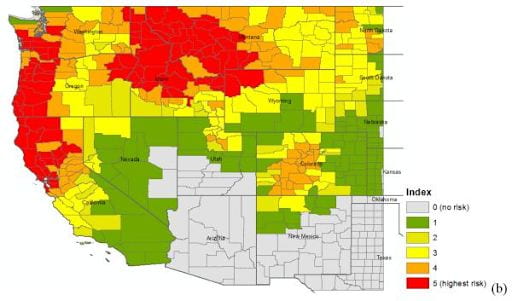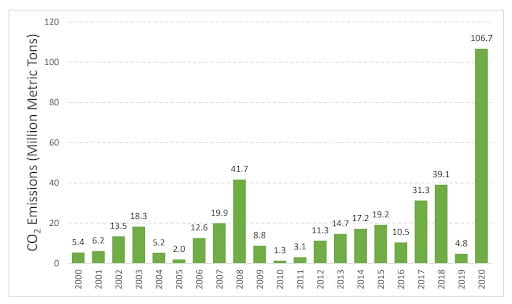California On Fire

California has already seen waves of climate induced wildfires, and as our planet’s climate warms they will only be more numerous and intense. To understand how wildfires today and in the future impact Californians requires a deep dive into climate injustice. Between air pollution, privilege, and the prison system, California’s wildfires show an ugly side of the state that we explore in this blog series.
Part 1: Pollution
Most of the wildfires in recent California history have been caused by human activity, but historically accidental sparks don’t cause wildfires or can be easily contained. Wildfires have always been a part of California’s climate, but in recent decades the length and intensity of the fire season has drastically increased. 2020 was historic in California due to the immense scale of wildfires, with 500 fires burning a total of 4.2 million acres(CARB). One fire in particular named the August Complex was the largest area burned ever recorded for a fire event(CARB). So why are these wildfires growing in size and intensity, and why so quickly? This is where climate change comes in. The California climate receives its moisture in fall and winter, with vegetation drying out in the summer. With recent increases in temperature, there has been a decrease in moisture retained by vegetation and an increase in how fast vegetation dries out. Dry vegetation burns easily, and catches fire much faster than plants holding moisture. Thus, California has become a state made of kindling just waiting for a spark, and the human population continues to provide it with just that. Of the top 20 largest wildfires recorded in California, over half occurred in the last decade, with five of the six largest occurring in just two months in 2020 (Masri, Shahir et al.). The changing climate coupled with human expansion into more rural, forested areas creates the perfect storm for wildfires, and the increasing rate of fires isn’t expected to die down anytime soon. Now and in the future, fire is one of the main threats to California residents, and it disproportionately affects socioeconomically disadvantaged and vulnerable groups.
While the physical damage from recent fires has been extensive, the real damage comes in the form of particulate matter, or PM, in smoke. Particulate matter contains microscopic solids or liquid droplets that can be inhaled. Particles less than 10 micrometers in diameter, or PM10, can get deep into your lungs and some may even get into your bloodstream. Of these, particles less than 2.5 micrometers in diameter, also known as fine particles or PM2.5, pose the greatest risk to public health (EPA). During wildfire episodes, smoke often results in two- to fourfold increases in concentrations of PM2.5 (Masri, Shahir et al.). PM can cause respiratory, cardiovascular, and cerebrovascular issues when inhaled. These health issues can range from asthma to heart disease, and the impacts of PM pollution on individuals lasts long after the smoke has cleared (Rosenthal, Annie et al.) Smoke pollution from wildfires is a particularly huge risk factor for vulnerable populations such as children, those with chronic illness, and the elderly. “Each year, globally, between 260,000 and 600,000 people die from smoke from wildfires” (Wallace-Wells). Smoke pollution doesn’t only affect areas near fires either. “Canadian fires have been linked to spikes in hospitalizations as far away as the Eastern Seaboard of the United States” (Wallace-Wells).
So what does this mean for the future? As wildfires increase, how will this affect the amount of people exposed to PM pollution? The answers are grim. “Under climate change, the average wildfire-specific PM2.5 level for the years 2046-2051 was estimated to increase approximately 160%”(Liu, Jia Coco et al.). This means, on average, there will be more than double previously recorded amounts of particulate matter pollution by 2046. Even more concerning, “maximum wildfire-specific PM2.5 level was estimated to increase by >400%” (Liu, Jia Coco et al.). Fires are expected to increase in intensity to where Californians will experience 4 times more particulate matter 2.5 at once than ever before.


Wildfire smoke risk for the May-October fire season for 2004-2009 (a) and the future under climate change in 2046-2051 (b). No risk areas are represented by gray, while the highest risk areas are red. Figure sourced from Liu, Jia Coco et al. “Particulate Air Pollution from Wildfires in the Western US under Climate Change.” Climatic change vol. 138,3 (2016): 655-666. doi:10.1007/s10584-016-1762-6
A better way to visualize the scope of PM pollution in the future is to put it in terms of “Smoke Waves”, two or more consecutive days with high wildfire-specific PM2.5. This term can be used to describe episodes of high air pollution from wildfires. Under climate change, it is estimated that more than 82 million individuals will experience a 57% and 31% increase in the frequency and intensity, respectively, of Smoke Waves.(Liu, Jia Coco et al.) As wildfires increase in frequency and intensity, so do the smoke waves. Smoke waves, however, can cover a much larger area than that actually touched by the fires, and are predicted to be a common threat in Northern California, Western Oregon and the Great Plains. The changes in smoke waves, combined with demographic trends, are anticipated to result in 7 million more children and 5.7 million more elderly people affected by smoke waves in the U.S. under climate change compared with the present day (Liu, Jia Coco et al.).
Though these increases in PM 2.5 pollution are the most pressing issue towards human health, the increase in wildfires is also leading to other issues in our atmosphere. Forests and other vegetation sequester carbon, or in other words store it away in the soil or in the plants themselves. Wildfires release huge amounts of carbon as those plants burn. In California during 2020, more than 106.7 million tons of CO2 was released into the atmosphere, along with 1,181 tons of previously mentioned PM2.5(CARB). While wildfire carbon emissions have previously been a natural cycling of carbon in the atmosphere, climate change has created a feedback loop that’s dangerous. As temperatures rise due to climate change fire seasons grow longer and more intense, as previously mentioned. The larger areas burned in California leave behind dried and dead vegetation which can catch on fire even more easily. These larger and more frequent fires release more carbon than ever before, and vegetation regrowth can’t sequester enough carbon to even out the emissions. Thus, more carbon in the atmosphere leads to increased warming, which begins the cycle again year after year, with fires becoming more frequent as the cycle continues. This can explain why fires have been exponentially increasing in recent years. And as fires grow larger so will the PM 2.5 emissions.

Estimate of wildfire CO2 emissions from 2000-2020
Wildfire Emission Estimates for 2020 – ww2.Arb.ca.gov. California Air Resources Board, https://ww2.arb.ca.gov/sites/default/files/2021-07/Wildfire%20Emission%20Estimates%20for%202020%20_Final.pdf.
There’s not a lot we can do about the air pollution from wildfires or climate feedback loops. However, preventing accidental fires in the first place is a great start. By reducing the amount of activities that could result in a fire hazard – including bonfires, fireworks, and even smoking cigarettes – you can help reduce the risk for wildfires. Be sure to also pay attention to government regulations on where those activities are allowed, so you can at least ensure you and your friends and family aren’t the next inadvertent firestarters. On a wider scope, government preparedness plans for public health regarding wildfires is necessary. Distribution of masks, free health checks for the vulnerable, and increased public outreach on fire safety can help those affected know the risks and be protected from PM pollution. With recent years of wildfires it has become clear that only the most privileged Californians are able to acquire the resources to protect themselves, their families, and their homes from wildfires. Going forward every citizen of California deserves to feel safe when faced with the threat of wildfires, and this stark contrast of privilege will be addressed in the next blogpost of the California on Fire series.
Sources:
Liu, Jia Coco et al. “Particulate Air Pollution from Wildfires in the Western US under Climate Change.” Climatic change vol. 138,3 (2016): 655-666. doi:10.1007/s10584-016-1762-6
Masri, Shahir et al. “Disproportionate Impacts of Wildfires among Elderly and Low-Income Communities in California from 2000-2020.” International journal of environmental research and public health vol. 18,8 3921. 8 Apr. 2021, doi:10.3390/ijerph18083921
“Particulate Matter (PM) Basics.” EPA, Environmental Protection Agency, www.epa.gov/pm-pollution/particulate-matter-pm-basics.
Rosenthal, Annie et al. “Health and social impacts of California wildfires and the deficiencies in current recovery resources: An exploratory qualitative study of systems-level issues.” PloS one vol. 16,3 e0248617. 26 Mar. 2021, doi:10.1371/journal.pone.0248617
Wallace-Wells, David. The Uninhabitable Earth: Life after Warming. Tim Duggan Books, 2020.
Wildfire Emission Estimates for 2020 – ww2.Arb.ca.gov. California Air Resources Board, https://ww2.arb.ca.gov/sites/default/files/2021-07/Wildfire%20Emission%20Estimates%20for%202020%20_Final.pdf.


